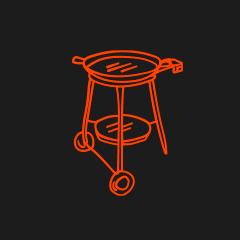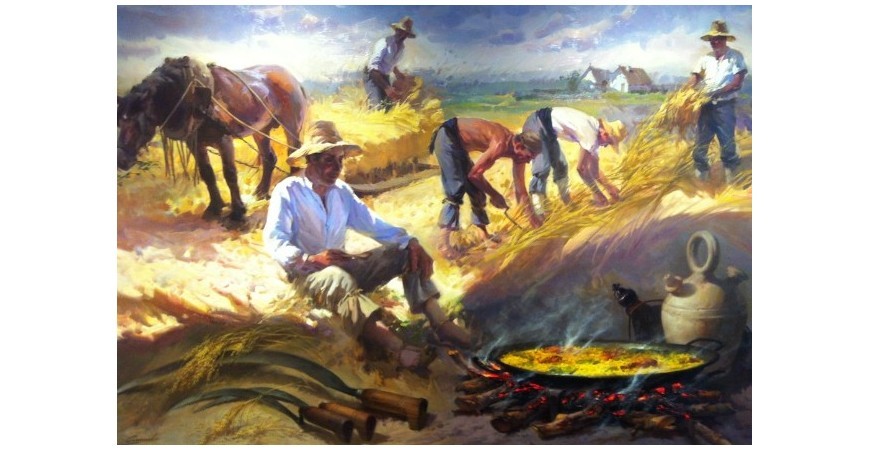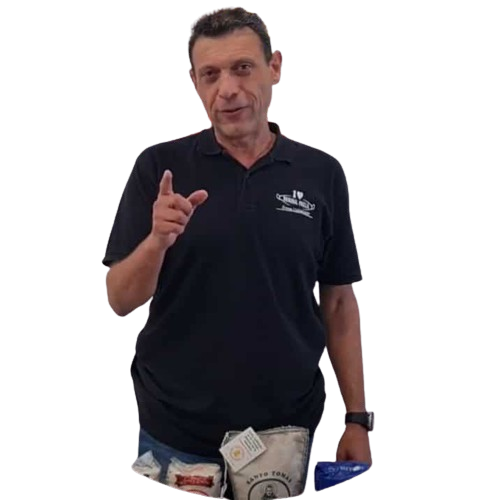Rules for eating paella
You’ve probably heard of or practiced some table etiquette rules when eating—like using chopsticks for sushi or something “fancier” like raising your pinky while sipping tea.
You might think that paella is free from such table manners, but you may be surprised to discover that, like many dishes, it has its own rules—ones that many rice masters might call the etiquette for eating paella.
In this blog post, we’re going to give you a quick overview of what people consider the rules for eating paella.
Where do these rules for eating paella come from?
Interestingly, what we might call the rules for eating paella go as far back as the dish’s very origins.
These “rules” emerged over years of communal paella meals, where diners’ particular ways of eating eventually became unwritten norms, passed on by word of mouth and applied to every paella dish—thus becoming part of the experience.
Not following them doesn’t mean you’re disrespecting the dish—far from it. The paella will taste just as good. They are simply traditions that bring us closer to experiencing paella the way it was enjoyed in the past—and how many still do today.
The authentic guide to eating paella: 8 basic rules
No plates: eat directly from the paella pan
A rule so common it's practically synonymous with the dish itself—paella is eaten directly from the paella pan, no need to serve it on individual plates.
Where you sit determines your section of the pan, and that’s where you should take your portion—as long as it’s right in front of you.
Back in the day, paella was typically made in the fields over a wood fire, and workers didn’t carry plates with them.
To avoid going back home for plates, everyone simply sat around the pan and ate from it. This became so popular that it’s now practically a rule every paella-lover knows instinctively—a defining feature of the dish.
Of course, if there are too many diners to make eating from the pan practical, it’s better to serve individual portions on plates.
Respect the “voreta”: your space is sacred
Traditionally called *cavallonet* or *voreta*, this refers to a kind of “wall” or dividing line of rice and ingredients that separates each diner’s portion.
The typical way to eat paella is for each person to eat from the part directly in front of them, from the edge inward toward the center.
Much like a cake or pizza, the pan is divided into slices based on each person’s position. This often results in triangular eating zones, leaving the center and sides untouched until later.
You don’t touch your neighbor’s triangle until they’ve finished theirs—or at least eaten what’s considered their share—so no one invades another person’s portion.
This is just good manners. Just like you wouldn’t want someone sticking their fork into your plate, no one likes someone eating from their paella portion.
The wooden spoon is the only acceptable one
Although today this rule is more flexible—most of us use whatever utensils we have at home—traditionally and even commonly today, paella is eaten with a spoon, specifically a wooden spoon from the pan, or with a fork from a plate.
According to rice masters, there are several reasons for the wooden spoon. Some say it helps press the rice onto the spoon, making it easier to scoop. Others say it prevents scratching the pan, unlike metal utensils.
But the real reason is more historical than technical: in the past, workers brought their own utensils to the fields. Since many meals were stews and broths, the spoon was the preferred tool—often of good quality and used for nearly everything.
It was even common for people to place their wooden spoon on their part of the paella when they finished eating, as a sign that they’d enjoyed it and were done—also signaling others they could help themselves to any leftovers.
This love for the spoon became a tradition, which is why many rice chefs insist paella is to be eaten with a spoon.
As for forks—if eating from a plate, they make it easier to cut meat or fish, especially without the support of the pan underneath.

Don’t like an ingredient? Move it to the center
The saying “to each their own” applies to food too—and paella is no exception.
If you’re not a fan of a certain ingredient, or you’re tired of eating it, it’s common to move it to the center. This way, others can take and enjoy it if they want. It’s a polite way to share what you don’t want.
Once the outer portions are gone and only the center and voreta remain, just move any unwanted ingredients to the side of your area so both you and others can access the center easily.
If someone wants those ingredients, they can ask, and you can gently pass them over with your spoon.
Meat or seafood stays on your side, not someone else’s
Without plates, it can be tricky to eat meat or fish from the pan—no one wants half-eaten food in their area.
The simple rule? Keep meat and fish in your own zone.
If it has bones or shells, leave them in a corner of your portion, or on a napkin beside you if seated at a table. No one wants to accidentally swallow a bone.
The pan should never be rotated
In some meals, rotating a central dish is normal—for example, to grab your favorite part of a stew or salad.
Not with paella! Rotating the pan is frowned upon—it can be seen as disrespectful and disrupts everyone’s designated portion.
If you want an ingredient that’s not in your section, kindly ask the person near it to pass it or place it in the center.
If you want lemon, ask first
Lemon is considered optional by many, used to drizzle a few drops over the paella.
If you’re one of those people, always ask first. Set aside some rice on your own portion so the juice doesn’t land on anyone else’s—unless your neighbors also want lemon.
Interestingly, lemon’s use on paella goes back to its early days—but not as a field ingredient or optional topping.
Factory or metalworkers often had sooty hands, and farmers’ hands were sweaty or greasy. Back then, lemon juice was commonly used to clean hands, thanks to its acidity and antibacterial properties.
Some say a culinary-minded worker decided not to waste the leftover lemon and drizzled it on the paella—starting a new tradition. Others say it became popular later due to tourists during Spain’s tourism boom.
Lemon was often used as decoration on seafood paella, and tourists, unaware of the custom, squeezed it on. Since they liked it, chefs went along, and it became an optional garnish.
Serving on plates? Always from the center
If there are too many people, or children who can’t reach the pan, the best solution is to serve on plates. But if you do, always serve from the center of the pan—what Valencians call “escudellar.” Usually, the cook serves to avoid accusations of favoritism.
This way, you don’t disturb the portions of those eating directly from the pan.
Obviously, if serving on plates was the plan from the start, serve from wherever makes sense.
Is there a utensil “language” in paella?
Foodies may know about utensil etiquette—different tools for different foods, or actions with symbolic meaning.
With paella, the spoon is our tool of communication: we eat with it, and placing it on our section signals we’re done and enjoyed the meal. Sometimes, it’s followed by a phrase like “estic fart, no puc més” (“I’m full, I can’t eat more”).
Eating paella: tradition, respect, and good taste
Like many foods or drinks, paella has customs rooted in tradition—shared among diners, without plates, gathered around the pan enjoying stories, laughter, and a break from daily seriousness.
These unwritten rules were built on this idea—showing respect among diners so everyone enjoys their share and avoids tension. It promotes unity over a beloved dish meant to be shared.
We hope this guide helps you enjoy paella the way it was meant to be—¡arrocer@s!




